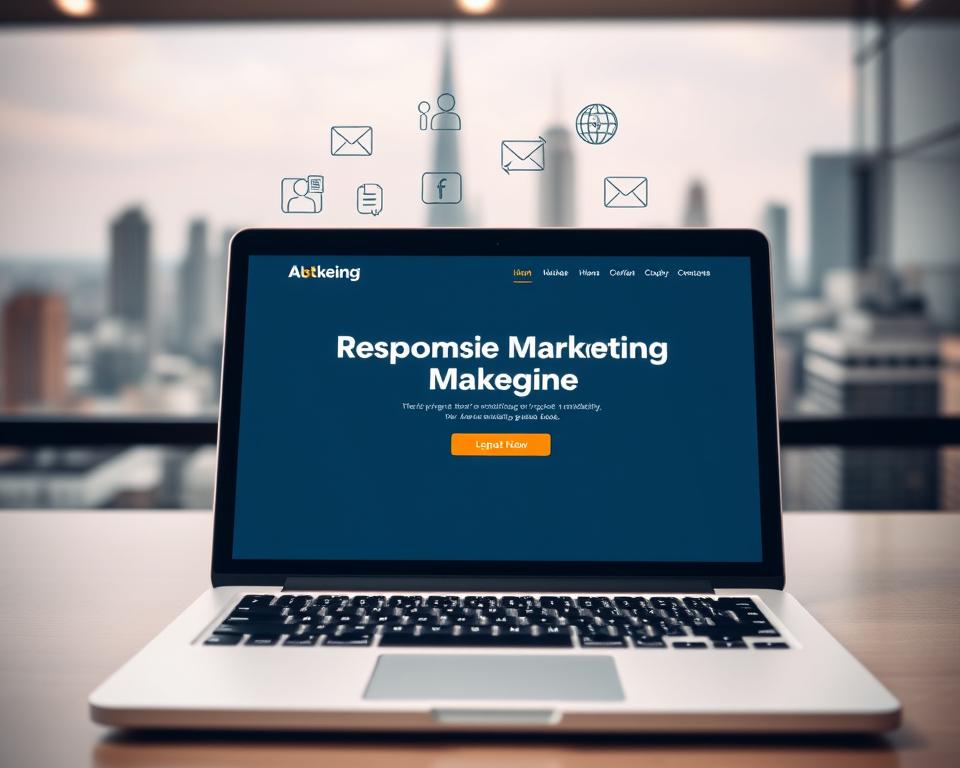Anúncios
business marketplace tools can change how you test demand, learn about audiences, and turn data into clear next steps. Which mix gives the fastest, most reliable insight without wasting budget?
You’ll see how smarter stacks drive better decisions by combining research platforms like GWI and Statista with search and content signals from Google Trends and BuzzSumo. Tableau and NIQ help you visualize and govern analytics, while Qualtrics, Typeform, and SurveyMonkey collect customer feedback quickly.
We map practical ways to match each platform to a job-to-be-done so you don’t duplicate capabilities. Real examples show how users refine messaging, prioritize website fixes, and connect insights to action with dashboards and simple governance habits.
Key Takeaways
- Learn which platforms answer different research and analytics questions.
- Use survey, social listening, and search validation to reduce guesswork.
- Match each tool to a clear job to avoid overinvesting.
- Start with free website and social media options to move fast.
- Focus on ethical data use, privacy, and realistic expectations.
Introduction: Why business marketplace tools matter right now
Channels are fragmenting and attention spans are shrinking, so you need clear data to guide every decision. You face many platforms, short windows to win attention, and a flood of information that can feel overwhelming.
The shift to data-led decisions across channels
Data-led choices help you spot what works across marketing and social media. When customers move from one channel to another, numbers show real behavior. That beats assumptions and reduces wasted time.
How Product Roundups help you compare options fast
Product roundups save time by grouping comparable tools and highlighting strengths. This roundup covers surveys (Qualtrics, SurveyMonkey), consumer data (GWI, Statista), social listening (Brandwatch, BrandMentions), content research (BuzzSumo), search validation (Google Trends, AnswerThePublic), analytics (Tableau, NIQ), and UX testing (Userlytics, Loop11).
“Compare side by side, pick what fits your target audience, and scale from quick wins to enterprise needs.”
- Customers interact across social media and channels, so you need the right data to invest where it counts.
- Roundups cut research time and show which solutions match your target audience and market.
- You’ll learn which options reveal the “why,” which measure the “what,” and which help you act across media.
How to choose business marketplace tools that fit your stack
Start by framing the decision: what questions must the platform answer for your team right now? Keep the scope narrow and testable so you compare like-for-like options.
Data quality, freshness, and coverage
Ask where data comes from, how often it is refreshed, and which markets and audiences it covers. Look for platforms that publish sampling notes and refresh cadence.
Integration, collaboration, and scalability
Check native connectors and open APIs so your software links to CRM, analytics, and workflow apps. Evaluate shared workspaces, permissions, and version control for cross-team management.
Security, compliance, and total cost of ownership
Confirm SOC 2, ISO 27001, and GDPR readiness plus data residency options. Map TCO beyond list pricing—count seats, data limits, add-ons, onboarding, and training hours.
Support, ease of use, and onboarding time
Prioritize platforms your users will adopt. Pilot with real tasks: build a dashboard, run a survey, or launch a listening query. Document success criteria before trials so you measure objectively.
- Quick checklist: data freshness, integrations, governance, compliance, onboarding time, and TCO.
- Use examples to map strengths — Tableau for governance, Qualtrics for templates, Typeform and SurveyMonkey for ease, NIQ for omnichannel analytics.
Market research and consumer insights platforms
Not all research platforms are the same—some size markets, others explain why people buy. Use this group when you need survey reach, quick facts, agile polling, or psychographic depth to guide strategy and creative.
GWI: Global consumer reach and specialist datasets
GWI gives access to views, behaviors, and interests from nearly 3 billion consumers across 53 countries. It also offers specialist datasets (auto, tech, gaming, luxury, travel, kids, and more).
Use GWI to profile audiences, size opportunity, and build rich persona segments for media targeting or product launches.
Statista: Quick stats and cross-industry forecasts
Statista covers roughly 80,000 topics across 170 industries in 150 countries. It’s ideal when you need fast information, directional analytics, and headline forecasts for reports or executive decks.
Attest and quantilope: fast pulses and end-to-end research
Attest is best for rapid, targeted polling that validates messaging or creative in days. It works well for short sprints and A/B checks.
quantilope (Consumer Intelligence Platform) supports end-to-end workflows—from survey design to dashboards—so you reduce handoffs and speed insights to action.
Resonate: psychographics to explain “why”
Resonate layers psychographic and behavioral data onto demographics to reveal motivations, values, and purchase drivers. Use it when you must move beyond who people are to why they choose brands or products.
- Combine platforms: Statista for market sizing, GWI for audience definition, Attest for quick tests, quantilope for workflow, and Resonate for motivations.
- Triangulate across sources and check regional coverage and field dates to avoid bias.
- Document assumptions, sampling notes, and caveats so stakeholders interpret information correctly.
Survey, feedback, and form builders to capture customer voice
Good feedback starts with a simple ask: short surveys, clear logic, and a plan to act on responses.
Qualtrics fits when you need enterprise-grade branching, 100+ question types, and deep CX or product analytics. It handles complex journeys and sends structured reports when you must map the end-to-end customer experience.
SurveyMonkey is fast to launch. Use it for quick panels and A/B checks thanks to 300+ question sets and access to the SurveyMonkey Audience of 175M respondents. Its AI-assisted survey intelligence speeds analysis.
Conversational, mobile-first options
Typeform and JotForm boost completion rates with conversational flows and thousands of templates. Typeform’s free tier and mobile-first design help capture richer user responses.
SurveySparrow adds chat-style surveys, recurring NPS, and native Slack/Teams integrations for fast follow-up.
CX analytics and review intelligence
Sogolytics gives enterprise CX and NPS analytics with advanced branching. Trustpilot Insights turns public reviews into sentiment trends and keyword themes to inform product and service fixes.
“Keep surveys short, pilot on mobile, and tag owners so insights turn into action.”
- Pick Qualtrics for deep logic and templates.
- Choose SurveyMonkey for speed and panel reach.
- Use Typeform/JotForm/SurveySparrow for easy use and higher completion rates.
Social listening, brand monitoring, and competitive intelligence
Monitor real-time chatter to spot reputation risks before they escalate. Social media and media mentions move fast, so you need systems that show trends as they happen.
Brandwatch and BrandMentions: real-time mentions and sentiment tracking
Use Brandwatch for deep sentiment and competitor comparisons. It surfaces share of voice and threaded conversations so you can see which topics drive positive or negative mentions.
BrandMentions is great for quick reputation checks and fast alerts when executive names or product terms spike.
BuzzSumo: content discovery and influencer vetting
BuzzSumo tracks media mentions, backlinks, and shares. Use it to find creators on Instagram and X, check engagement, and pick influencers whose audiences match your goals.
Clarabridge: NLP for open-ended feedback
Clarabridge analyzes comments, chat transcripts, and reviews across languages. It extracts emotions, intent, and themes you’d miss manually and feeds those insights into product, PR, and support workflows.
- Combine listening analytics with campaign metrics to prioritize formats that move the needle.
- Create alerts for priority keywords and map influencer shortlists by audience overlap.
- Set a weekly cadence: sentiment snapshot, share of voice, and top conversation drivers.
Search and trend tools to validate market demand
Compare regional interest and timing so you know where to launch and which channels deserve spend.

Google Trends: Real-time interest by location and time
Use Google Trends to compare topics over weeks, months, or years. It shows interest by region so you can prioritize markets and tailor timing.
Look for seasonal spikes to plan inventory, media, and channels. Track a small set of core terms weekly to spot lift from PR or campaigns.
AnswerThePublic: Questions people ask to inform messaging
AnswerThePublic listens to autocomplete and surfaces the questions users type. The free tier gives three searches per day; Pro adds listening alerts.
Turn top questions into FAQs, blog outlines, and ad copy so your messaging mirrors real searches and improves marketing relevance.
- Pair Trends with social listening to check whether interest is sustained across media or driven by a short event.
- Export trend data to your dashboard so demand signals work alongside conversion metrics.
- Use these two tools together to validate market demand and shape search-driven content.
Analytics and data visualization for decision-making
The right visual layer links retail signals and internal metrics so you can act fast. Pairing BI dashboards with purchase panels helps you see both intent and transactions.
Tableau: Visual analytics, governance, and data storytelling
Tableau turns raw numbers into clear analytics you can trust. Use its data models, permissions, and certified sources to keep one version of the truth for your teams.
AI-assisted insights speed exploration and let users build narrative dashboards. Those stories help executives, analysts, and field teams focus on outcomes, not spreadsheets.
NIQ (NielsenIQ) and Full View: omnichannel purchase behavior
NIQ provides omnichannel purchase data so you see how shoppers move across retailers and categories. Full View blends retail measurement with panel insights for share shifts and whitespace signals.
Use NIQ when you need actual purchase behavior. Use BI when you need flexible exploration, governance, and storytelling tied to execution.
- Executives: outcome summaries that show market share and growth.
- Analysts: flexible dashboards for deep exploration and testing.
- Field teams: clear action lists mapped to territories and promotions.
“Pair BI dashboards with retail outputs to link market performance to your sales and marketing execution.”
- Build a measurement layer that aligns KPIs across various sources so reports tell a consistent story.
- Use platform features for management: certified sources, access controls, and audit trails.
- Combine Tableau storytelling with NIQ Full View to move from insight to repeatable action.
UX and product testing to improve user experience
Testing your product helps you spot where users hesitate and what features actually help them. Mix task-based sessions with micro-surveys to capture both behavior and sentiment.
Moderated tests let you watch someone think aloud, probe choices, and ask “why” in the moment. Use Userlytics for moderated remote sessions: it records interviews, runs without downloads, and uses AI synthesis and sentiment analysis to speed insight.
Unmoderated tests scale faster and reduce scheduling friction. Loop11 runs no-code tests on desktop, mobile, or tablet, then creates highlight clips, timestamped notes, and UX metrics to share with stakeholders.
In-flow micro-surveys and nudges
On-page nudges catch sentiment when it matters. Qualaroo times short, targeted surveys with Nudge tech and offers templates for quick setup.
Temper gives tiny embeddable icons (sad/neutral/happy) you can place inline, in tabs, or in emails to collect ongoing feedback with minimal disruption.
“Mix task-based tests with quick micro-feedback to catch both usability issues and overall experience sentiment.”
- Use moderated Userlytics studies to observe choices and probe decisions.
- Run unmoderated Loop11 tests to validate prototypes and live flows quickly.
- Add Qualaroo nudges on friction points and Temper icons on key journeys.
- Tag themes—navigation, content clarity, checkout—so owners can prioritize fixes with evidence.
- Integrate short testing cycles into sprints so you ship regular improvements instead of big, risky updates.
Free and low-cost marketing tools for small businesses
A simple starter stack gets your website live, builds an email list, and keeps your social media active without heavy pricing. Start with a few dependable options and add features as you grow.
Website, email, and social basics
Launch a quick website on Wix to publish hours, services, and contact info fast. Wix has a free plan, so you can upgrade later as needs change.
Start email lists with Mailchimp (free up to 500 subscribers) or MailerLite (free up to 1,000). Both include forms, landing pages, and templates to ship campaigns quickly.
Use Canva for on-brand graphics and templates. Schedule posts with Buffer (free scheduling on three channels) to save time and keep a steady cadence.

Why free channels still win
Email delivers strong returns—estimates show it can return about $36 for every $1 spent. Even a monthly newsletter drives repeat visits and referrals.
- Optimize for local search: keep your website info accurate and match your profiles.
- Pick one or two channels where your customers are and focus there.
- Track simple KPIs first—sign-ups, clicks, and calls—so you know what to scale.
Launch fast, measure small, and invest in what moves the needle.
Choosing the right social platforms for your target audience
Match platform format to your goals: discovery, thought leadership, or fast conversation. Pick the platforms where your target audience already spends time and where your content fits the native format.
Facebook, Instagram, X (Twitter), LinkedIn: Where engagement differs
Use LinkedIn for B2B thought leadership and professional updates. It suits long-form posts, case studies, and white papers that speak to industry decisions.
Instagram is best for visual discovery and brand storytelling. Carousels, Reels, and shoppable posts help drive inspiration and saves.
X works for real-time conversation and announcements. Choose X when you need immediacy and short, timely exchanges with users and media.
YouTube, Pinterest, TikTok: Video and visual discovery at scale
YouTube fits longer explainers and tutorials that teach users how to use your product or service. It’s ideal for search-driven discovery and deeper storytelling.
Pinterest supports inspiration-led journeys. Use it when consumers plan purchases or collect ideas—pin visual guides and seasonal boards.
TikTok excels at short-form creative reach with younger audiences. Prioritize native-feeling vertical video and trends to drive organic discovery.
- Align campaigns to platform strengths: vertical video for TikTok, Reels and carousels for Instagram, and professional posts on LinkedIn.
- Start on one or two platforms where your users are, test content, then scale paid placements after you see organic signals.
- Create platform-native CTAs so the user experience stays seamless and expectations match the format.
Data privacy, compliance, and responsible use
Privacy and compliance should be baked into every analytics project from day one. Start by collecting only the information you need and ask for clear consent where required. Make choices obvious so customers can control how their information is used.
Set simple management policies for access, permissions, and retention. Use role-based access and audit logs so sensitive records stay protected and accountable.
Verify vendor security posture and processing locations before you sign. Platforms like Tableau, Clarabridge, and NIQ highlight governance and secure handling of feedback and analytics, which helps align contracts with your compliance needs.
Limit PII exposure in reports and anonymize where possible. Train your team on responsible social media monitoring and acceptable data practices to protect your brand and product reputation.
- Collect minimal information and document consent.
- Define access rules, retention schedules, and audit trails.
- Confirm vendor security and legal alignment with your companies’ policies.
- Remove or mask PII in dashboards and use role-based views.
- Educate staff on ethical use of social media and customer data.
From tools to outcomes: implementation roadmap and measurement
Turn strategy into measurable progress with a clear roadmap from goals to dashboards.
Define goals, map the funnel, and pick by job-to-be-done
Define one to three measurable goals—revenue lift, lead quality, or retention—and map the funnel that leads to them.
Pick platforms by job-to-be-done so the selected tools help outcomes, not create noise. Use SurveyMonkey or Typeform for feedback, and Tableau for analytics that connect to sales and retention.
Integrations, templates, and dashboards your team will use
Connect forms, email, analytics, and listening so data flows without manual uploads. Prioritize native connectors and simple automations first.
Use templates for surveys, dashboards, and campaign briefs to cut time from idea to launch. Keep a single analytics layer with source-of-truth metrics tied to sales, not vanity signals.
Enable your team: communication and flexible pay to boost execution
Management rituals matter: weekly KPI reviews, monthly experiments, and quarterly roadmap resets keep focus.
Support execution with a team messenger like Homebase for quick updates and clear owners for each campaign. Consider flexible pay options such as Cash Out to improve morale—happy teams deliver consistent campaign results.
“Start small, ship fast, and iterate based on data; retire what doesn’t work to keep your stack lean.”
- Define goals, map your funnel, then choose by job-to-be-done so tools help outcomes.
- Integrate systems first and use templates to reduce time to launch.
- Set a simple analytics layer tied to sales and retention; run regular management reviews.
- Route feedback to product and brand owners and publish a short “what we changed” log.
Conclusion
Real results come from disciplined testing, clear measurement, and modest bets. Match a small set of platforms—like Google Trends, Brandwatch, Tableau, Qualtrics, or SurveyMonkey—to specific goals and owners.
Validate demand, listen across media, and use simple dashboards to turn data into action. Keep your stack lean: adopt only the features your team will use and watch pricing as you scale.
Management habits matter. Schedule quick reviews, tag owners for fixes, and iterate based on feedback so your brand and sales improve steadily.
If you’re unsure, ask peers, mentors, or a professional to pressure-test assumptions. Stay flexible, keep learning, and let measured experiments guide your next move.



